2006 FORD F SERIES MOTORHOME AND COMMERCIAL CHASSIS jump start
[x] Cancel search: jump startPage 1 of 128

Introduction 3
Instrument Cluster 8
Warning and control lights 8
Gauges 12
Lights 15
Headlamps 15
Turn signal control 16
Bulb replacement 16
Driver Controls 17
Windshield wiper/washer control 17
Steering wheel adjustment 17
Speed control 18
Tires, Wheels and Loading 21
Tire Information 22
Tire Inflation 23
Changing tires 27
Lug Nut Torque 31
Vehicle loading 40
Trailer towing 47
Driving 50
Starting 50
Brakes 54
Transmission operation 58
Roadside Emergencies 63
Getting roadside assistance 63
Hazard flasher switch 63
Fuel pump shut-off switch 64
Fuses and relays 65
Jump starting 72
Wrecker towing 77
Table of Contents
1
2006 Motorhome(mot)
Supplement
USA_English(fus)
Table of Contents
Page 63 of 128
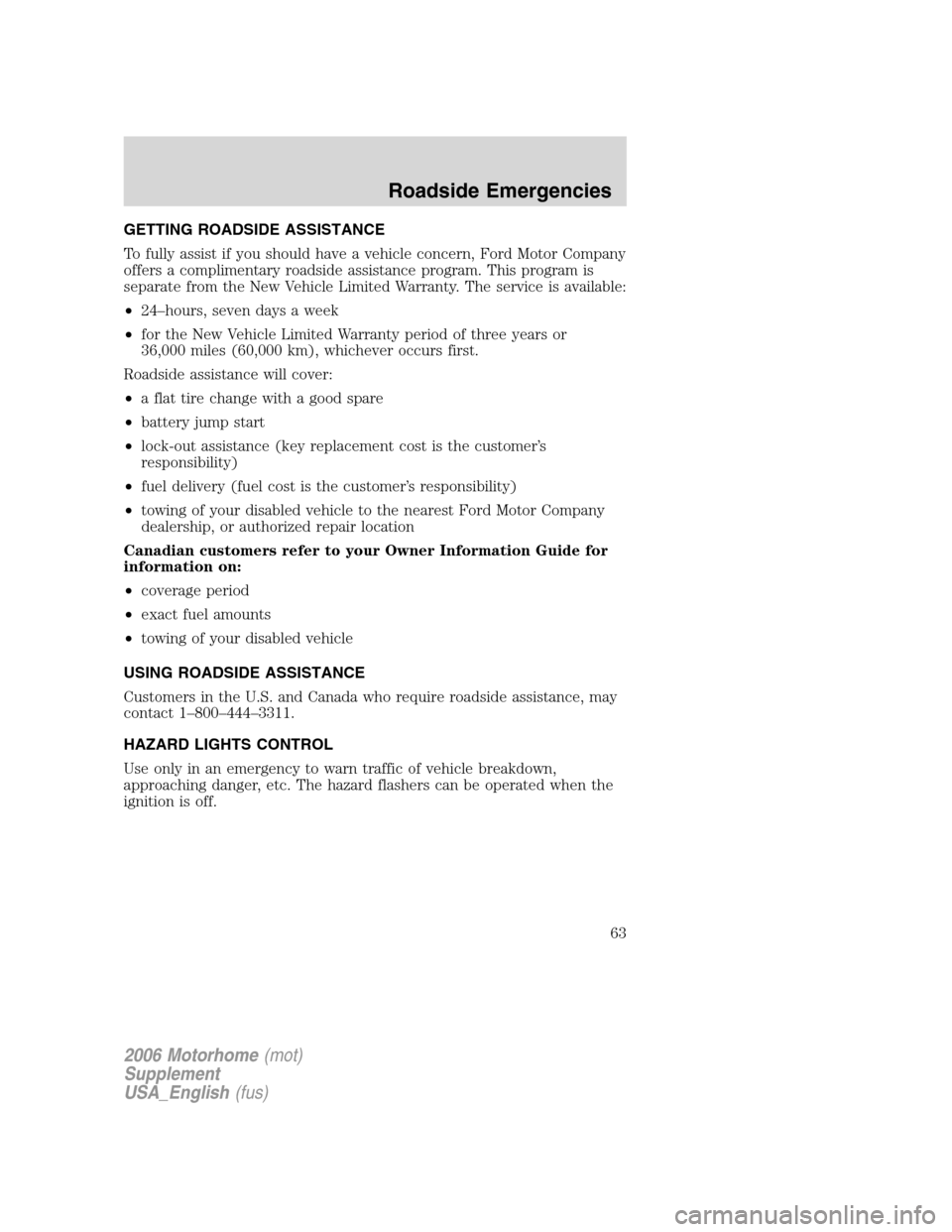
GETTING ROADSIDE ASSISTANCE
To fully assist if you should have a vehicle concern, Ford Motor Company
offers a complimentary roadside assistance program. This program is
separate from the New Vehicle Limited Warranty. The service is available:
•24–hours, seven days a week
•for the New Vehicle Limited Warranty period of three years or
36,000 miles (60,000 km), whichever occurs first.
Roadside assistance will cover:
•a flat tire change with a good spare
•battery jump start
•lock-out assistance (key replacement cost is the customer’s
responsibility)
•fuel delivery (fuel cost is the customer’s responsibility)
•towing of your disabled vehicle to the nearest Ford Motor Company
dealership, or authorized repair location
Canadian customers refer to your Owner Information Guide for
information on:
•coverage period
•exact fuel amounts
•towing of your disabled vehicle
USING ROADSIDE ASSISTANCE
Customers in the U.S. and Canada who require roadside assistance, may
contact 1–800–444–3311.
HAZARD LIGHTS CONTROL
Use only in an emergency to warn traffic of vehicle breakdown,
approaching danger, etc. The hazard flashers can be operated when the
ignition is off.
2006 Motorhome(mot)
Supplement
USA_English(fus)
Roadside Emergencies
Roadside Emergencies
63
Page 72 of 128
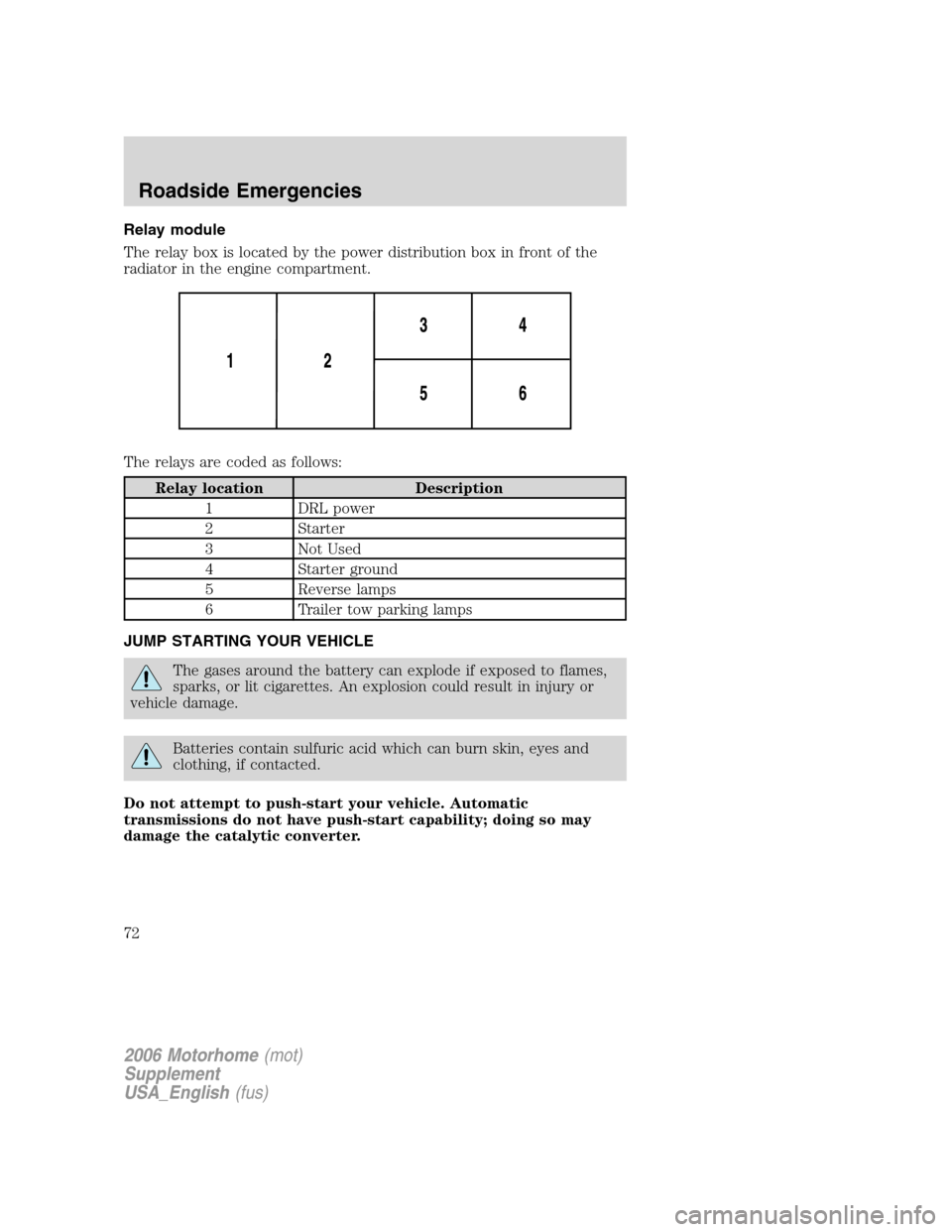
Relay module
The relay box is located by the power distribution box in front of the
radiator in the engine compartment.
The relays are coded as follows:
Relay location Description
1 DRL power
2 Starter
3 Not Used
4 Starter ground
5 Reverse lamps
6 Trailer tow parking lamps
JUMP STARTING YOUR VEHICLE
The gases around the battery can explode if exposed to flames,
sparks, or lit cigarettes. An explosion could result in injury or
vehicle damage.
Batteries contain sulfuric acid which can burn skin, eyes and
clothing, if contacted.
Do not attempt to push-start your vehicle. Automatic
transmissions do not have push-start capability; doing so may
damage the catalytic converter.
2006 Motorhome(mot)
Supplement
USA_English(fus)
Roadside Emergencies
72
Page 73 of 128
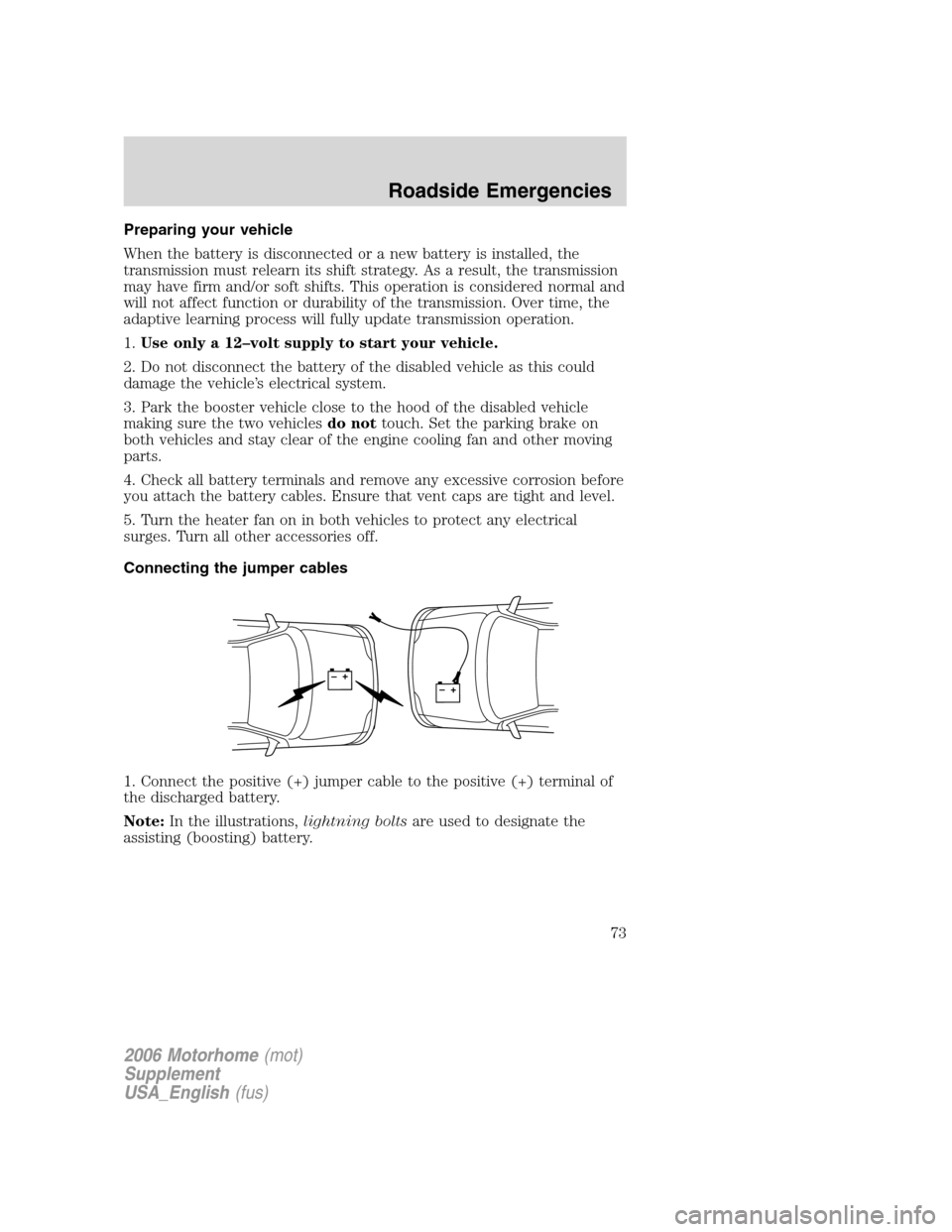
Preparing your vehicle
When the battery is disconnected or a new battery is installed, the
transmission must relearn its shift strategy. As a result, the transmission
may have firm and/or soft shifts. This operation is considered normal and
will not affect function or durability of the transmission. Over time, the
adaptive learning process will fully update transmission operation.
1.Use only a 12–volt supply to start your vehicle.
2. Do not disconnect the battery of the disabled vehicle as this could
damage the vehicle’s electrical system.
3. Park the booster vehicle close to the hood of the disabled vehicle
making sure the two vehiclesdo nottouch. Set the parking brake on
both vehicles and stay clear of the engine cooling fan and other moving
parts.
4. Check all battery terminals and remove any excessive corrosion before
you attach the battery cables. Ensure that vent caps are tight and level.
5. Turn the heater fan on in both vehicles to protect any electrical
surges. Turn all other accessories off.
Connecting the jumper cables
1. Connect the positive (+) jumper cable to the positive (+) terminal of
the discharged battery.
Note:In the illustrations,lightning boltsare used to designate the
assisting (boosting) battery.
+–+–
2006 Motorhome(mot)
Supplement
USA_English(fus)
Roadside Emergencies
73
Page 75 of 128
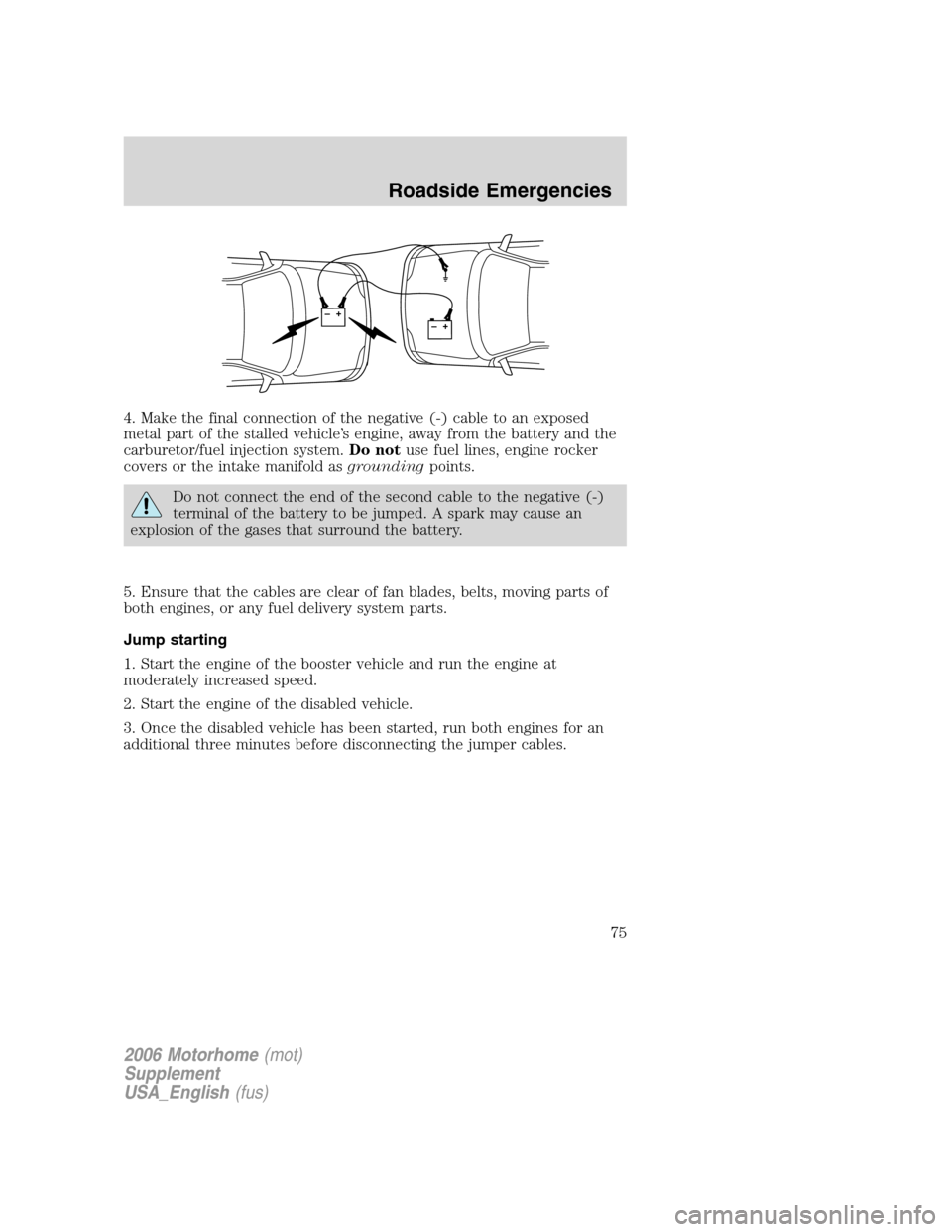
4. Make the final connection of the negative (-) cable to an exposed
metal part of the stalled vehicle’s engine, away from the battery and the
carburetor/fuel injection system.Do notuse fuel lines, engine rocker
covers or the intake manifold asgroundingpoints.
Do not connect the end of the second cable to the negative (-)
terminal of the battery to be jumped. A spark may cause an
explosion of the gases that surround the battery.
5. Ensure that the cables are clear of fan blades, belts, moving parts of
both engines, or any fuel delivery system parts.
Jump starting
1. Start the engine of the booster vehicle and run the engine at
moderately increased speed.
2. Start the engine of the disabled vehicle.
3. Once the disabled vehicle has been started, run both engines for an
additional three minutes before disconnecting the jumper cables.
+–+–
2006 Motorhome(mot)
Supplement
USA_English(fus)
Roadside Emergencies
75
Page 77 of 128
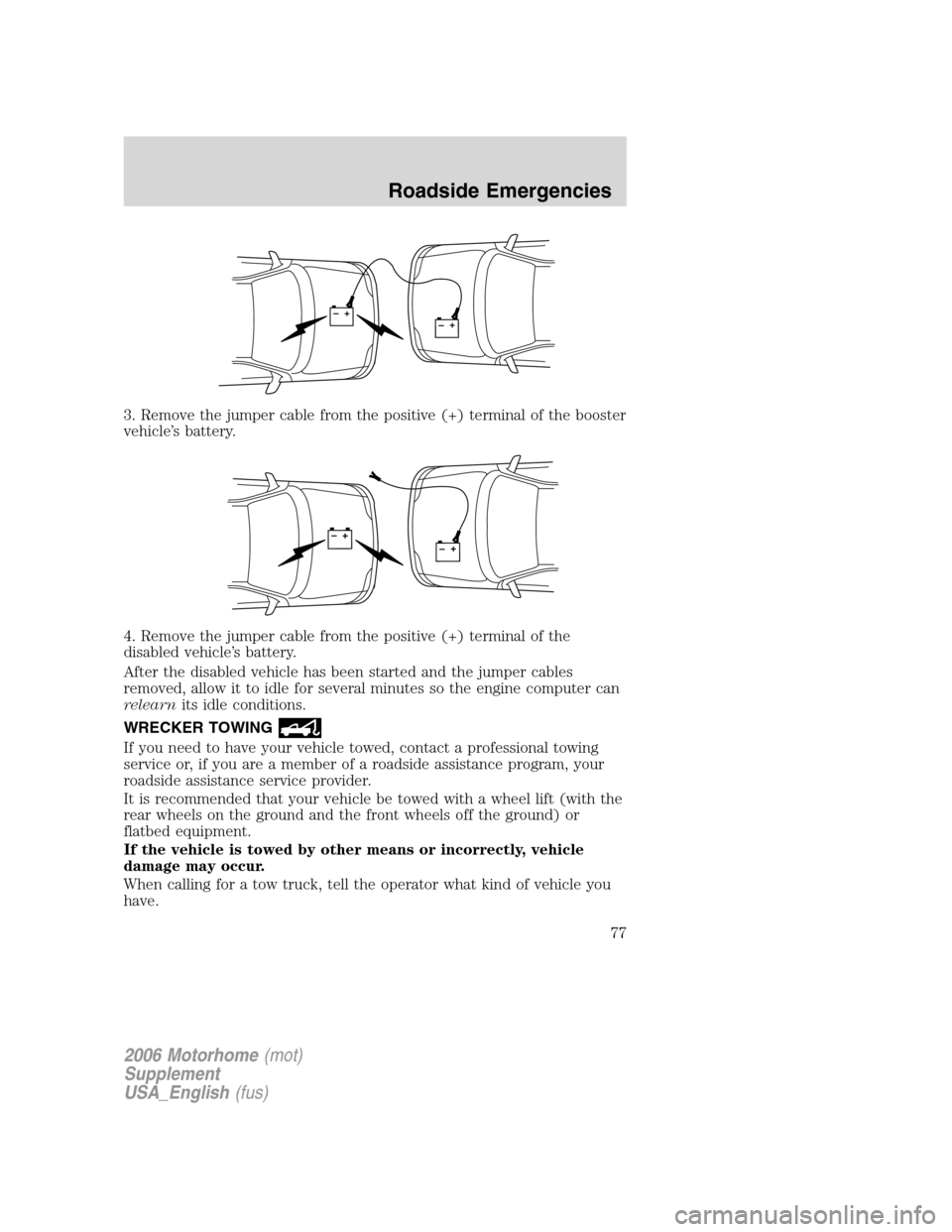
3. Remove the jumper cable from the positive (+) terminal of the booster
vehicle’s battery.
4. Remove the jumper cable from the positive (+) terminal of the
disabled vehicle’s battery.
After the disabled vehicle has been started and the jumper cables
removed, allow it to idle for several minutes so the engine computer can
relearnits idle conditions.
WRECKER TOWING
If you need to have your vehicle towed, contact a professional towing
service or, if you are a member of a roadside assistance program, your
roadside assistance service provider.
It is recommended that your vehicle be towed with a wheel lift (with the
rear wheels on the ground and the front wheels off the ground) or
flatbed equipment.
If the vehicle is towed by other means or incorrectly, vehicle
damage may occur.
When calling for a tow truck, tell the operator what kind of vehicle you
have.
+–+–
+–+–
2006 Motorhome(mot)
Supplement
USA_English(fus)
Roadside Emergencies
77
Page 123 of 128
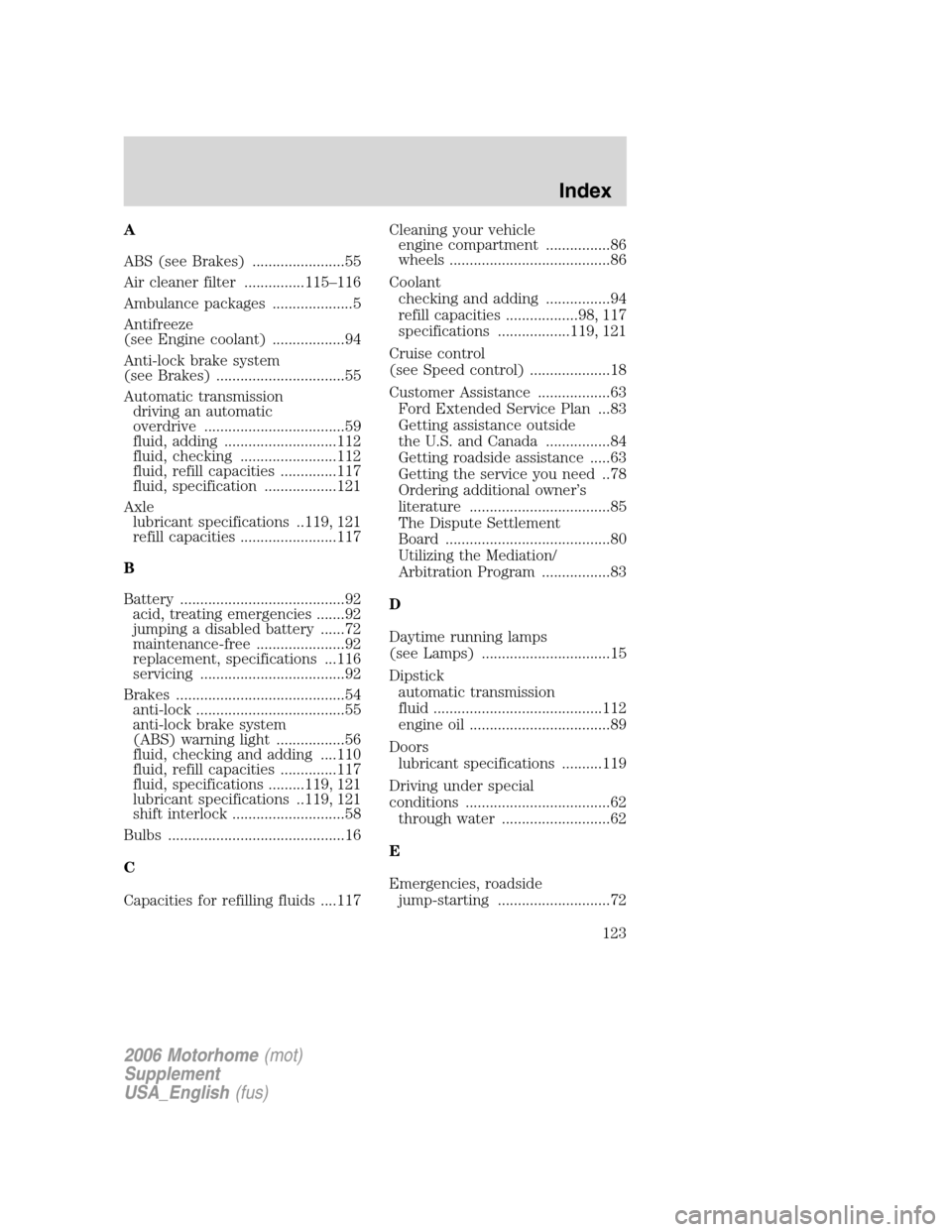
A
ABS (see Brakes) .......................55
Air cleaner filter ...............115–116
Ambulance packages ....................5
Antifreeze
(see Engine coolant) ..................94
Anti-lock brake system
(see Brakes) ................................55
Automatic transmission
driving an automatic
overdrive ...................................59
fluid, adding ............................112
fluid, checking ........................112
fluid, refill capacities ..............117
fluid, specification ..................121
Axle
lubricant specifications ..119, 121
refill capacities ........................117
B
Battery .........................................92
acid, treating emergencies .......92
jumping a disabled battery ......72
maintenance-free ......................92
replacement, specifications ...116
servicing ....................................92
Brakes ..........................................54
anti-lock .....................................55
anti-lock brake system
(ABS) warning light .................56
fluid, checking and adding ....110
fluid, refill capacities ..............117
fluid, specifications .........119, 121
lubricant specifications ..119, 121
shift interlock ............................58
Bulbs ............................................16
C
Capacities for refilling fluids ....117Cleaning your vehicle
engine compartment ................86
wheels ........................................86
Coolant
checking and adding ................94
refill capacities ..................98, 117
specifications ..................119, 121
Cruise control
(see Speed control) ....................18
Customer Assistance ..................63
Ford Extended Service Plan ...83
Getting assistance outside
the U.S. and Canada ................84
Getting roadside assistance .....63
Getting the service you need ..78
Ordering additional owner’s
literature ...................................85
The Dispute Settlement
Board .........................................80
Utilizing the Mediation/
Arbitration Program .................83
D
Daytime running lamps
(see Lamps) ................................15
Dipstick
automatic transmission
fluid ..........................................112
engine oil ...................................89
Doors
lubricant specifications ..........119
Driving under special
conditions ....................................62
through water ...........................62
E
Emergencies, roadside
jump-starting ............................72
2006 Motorhome(mot)
Supplement
USA_English(fus)
Index
123
Page 124 of 128
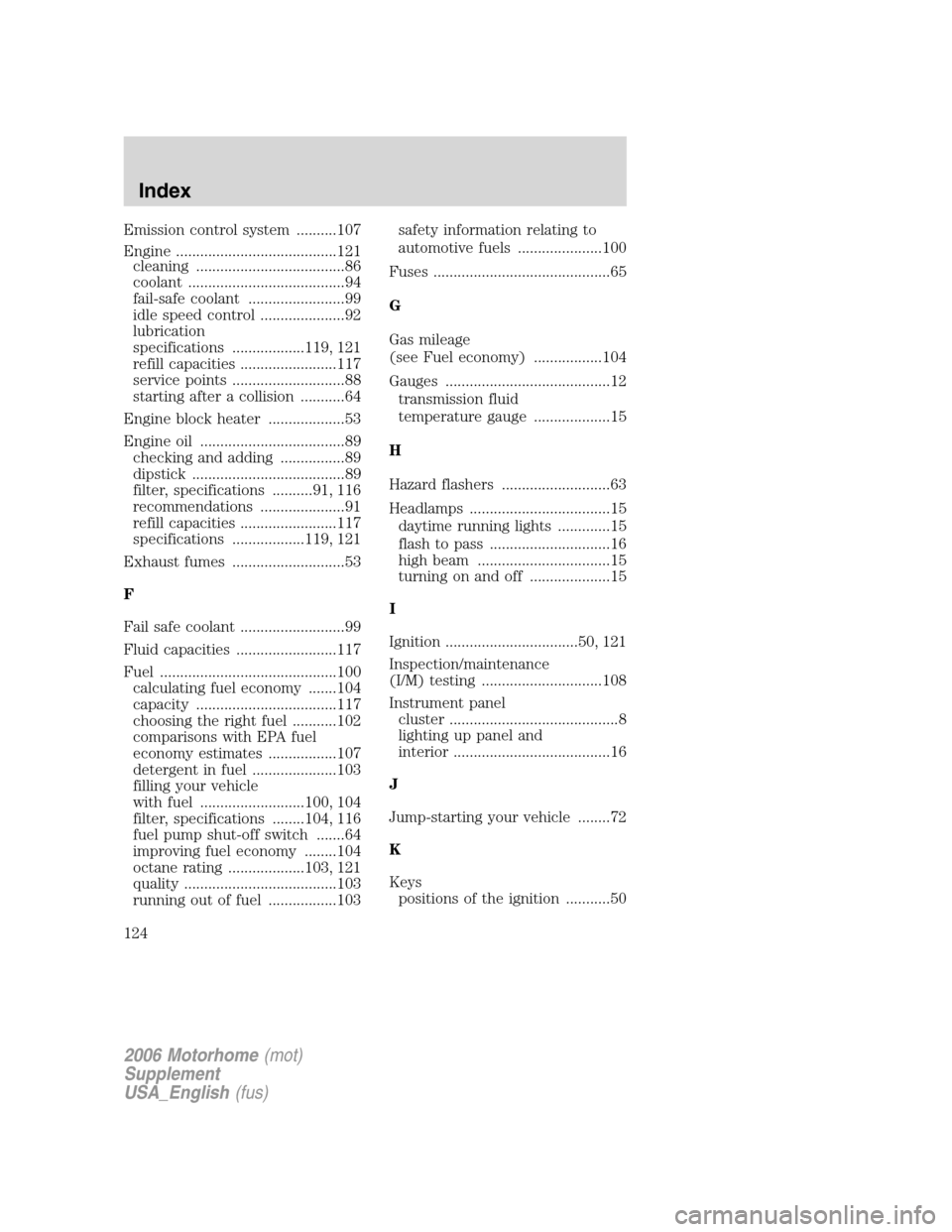
Emission control system ..........107
Engine ........................................121
cleaning .....................................86
coolant .......................................94
fail-safe coolant ........................99
idle speed control .....................92
lubrication
specifications ..................119, 121
refill capacities ........................117
service points ............................88
starting after a collision ...........64
Engine block heater ...................53
Engine oil ....................................89
checking and adding ................89
dipstick ......................................89
filter, specifications ..........91, 116
recommendations .....................91
refill capacities ........................117
specifications ..................119, 121
Exhaust fumes ............................53
F
Fail safe coolant ..........................99
Fluid capacities .........................117
Fuel ............................................100
calculating fuel economy .......104
capacity ...................................117
choosing the right fuel ...........102
comparisons with EPA fuel
economy estimates .................107
detergent in fuel .....................103
filling your vehicle
with fuel ..........................100, 104
filter, specifications ........104, 116
fuel pump shut-off switch .......64
improving fuel economy ........104
octane rating ...................103, 121
quality ......................................103
running out of fuel .................103safety information relating to
automotive fuels .....................100
Fuses ............................................65
G
Gas mileage
(see Fuel economy) .................104
Gauges .........................................12
transmission fluid
temperature gauge ...................15
H
Hazard flashers ...........................63
Headlamps ...................................15
daytime running lights .............15
flash to pass ..............................16
high beam .................................15
turning on and off ....................15
I
Ignition .................................50, 121
Inspection/maintenance
(I/M) testing ..............................108
Instrument panel
cluster ..........................................8
lighting up panel and
interior .......................................16
J
Jump-starting your vehicle ........72
K
Keys
positions of the ignition ...........50
2006 Motorhome(mot)
Supplement
USA_English(fus)
Index
124